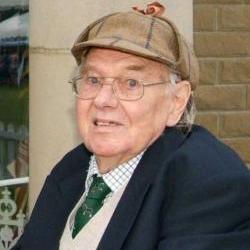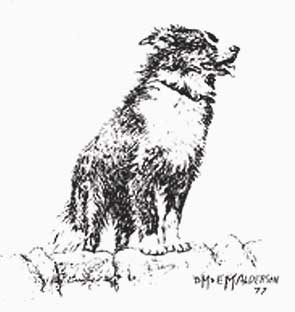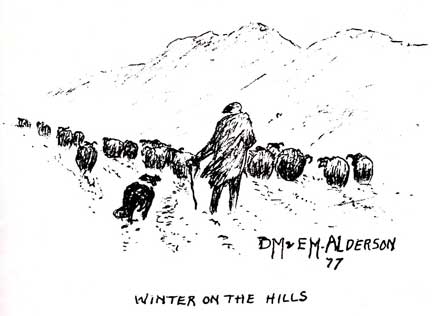

![]()
EDWARD HART
1925 - 2011

Edward Hart in a detail from a photo taken in 2010
when he received a long service award from the Yorkshire Agricultural Society
in recognition of his lengthy writing career.
(Thanks to Peter Hill, Member Communications for the British Guild of Agricultural Journalists
and Judy Thompson, Press Officer of the Yorkshire Agricultural Society.)
Edward Hart, who died at age 86, was an agricultural journalist with many books to his name, including The Hill Shepherd, and The Sheep Dog, Its Work and Training with well-known trialist Tim Longton.
Hart was born in Yorkshire, the grandson of a breeder of Hackney horses. He attended the Yorkshire Institute of Agriculture and spent eight years as a farm worker. The Telegraph, in their obituary for Hart, said he "was the last agricultural journalist with a working knowledge of heavy horses—experience he gained during the Second World War behind a pair hitched to a plough." He later wrote for Heavy Horse World magazine and authored five books on heavy horses.
Hart bought a hill farm in North Yorkshire in 1951 and began to write for the Northern Echo, a North Yorkshire newspaper. After farming for twelve years, Hart sold his farm and began a full time career as an agricultural journalist and author of books on agricultural subjects. His farming career was manifold, thus Hart became an expert in most rural crafts; and his writing was equally diverse. He wrote books on livestock, including heavy horses, driving horses and trekking ponies, and on sheep and hefting. But not just on livestock. Hart wrote books on dry stone walling, fencing, and hedging, books on walking sticks and shepherds crooks, and one on working dogs in collaboration with his then wife, Audrey.
 Hart had a special interests in sheepdogs and hill farming. In 1965 he launched a column in the Yorkshire Post based on the rotating diaries of a set of five real-life farming families, and every week for 45 years Hart would call one of "his farmers" to hear of their successes and failures and phone in his report to the newspaper. It was read avidly by both farmers and townspeople and became very popular. His 1977 book, The Hill Shepherd is based on those stories. In 1976 Hart collaborated with Tim Longton, the well-known Lancashire hill farmer and sheepdog trialist, to write The Sheep Dog: Its Work and Training. Both these books are admirably illustrated by D.M. and E.M. Alderson (British twin sisters and artists, Dorothy Margaret Alderson (1900-1992) and Elizabeth Mary Alderson (1900-1988), who were also known for their paintings of hunting scenes and horses) and published by David and Charles, Newton Abbot. And in 2005, Edward Hart wrote Jim Cropper: The Dog Man for Working Sheepdog, Andrew and Pauline Hall's publishing enterprise, in which Jim Cropper "talks" to Hart, similarly to the way that Tim Longton talked to him for the 1976 book.
Hart had a special interests in sheepdogs and hill farming. In 1965 he launched a column in the Yorkshire Post based on the rotating diaries of a set of five real-life farming families, and every week for 45 years Hart would call one of "his farmers" to hear of their successes and failures and phone in his report to the newspaper. It was read avidly by both farmers and townspeople and became very popular. His 1977 book, The Hill Shepherd is based on those stories. In 1976 Hart collaborated with Tim Longton, the well-known Lancashire hill farmer and sheepdog trialist, to write The Sheep Dog: Its Work and Training. Both these books are admirably illustrated by D.M. and E.M. Alderson (British twin sisters and artists, Dorothy Margaret Alderson (1900-1992) and Elizabeth Mary Alderson (1900-1988), who were also known for their paintings of hunting scenes and horses) and published by David and Charles, Newton Abbot. And in 2005, Edward Hart wrote Jim Cropper: The Dog Man for Working Sheepdog, Andrew and Pauline Hall's publishing enterprise, in which Jim Cropper "talks" to Hart, similarly to the way that Tim Longton talked to him for the 1976 book.
A chapter in The Hill Shepherd is devoted to "The Shepherd's Dogs" from which I would like to quote:
Each shepherd has at least two dogs, and probably four or five, to allow for injuries, bitches on heat or nursing pups, or partly trained youngsters. Often the shepherd has kept the same strain for years, even though he may have changed his job several times. Inherited traits are brought out by the hill shepherd, who likes to train his own dog from puppyhood. Sensible strains of sheep dog breed a high proportion of pups with an eye for sheep. An example of this is the famous Mindrum strain bred by...Northumbrian shepherd Bob Fraser. Any Border collie bearing the Mindrum prefix is expected to use its brains and work hard; it does not give in to an ill-tempered ewe, or turn tail when herding a really big mob...
The main difference between trials dogs and the rest is often just a question of extra polish...
The most fashionable Border collie colours are black-and-white and tricolour. The tricolour is generally black, white and tan, but brown, white and tan is becoming more in evidence. Brown and white collies can be very handsome...Another colour making more impact is the merle...Though most collies have dark brown eyes, the merle's are often bright blue, although some have eyes of different colours; many blue merles have one brown and one blue eye. A merle's blue eye may be mistakenly associated with blindness; this is not so, as the many excellent working merles prove. Shepherds do not always favour light colours for qhite another reason; they know that a dog with too much white on its body is not easily seen by the sheep. Yet another colour variation is the mottle, which is spotting of the legs and face and does not appear until the pup is three or four months old.
The word 'eye' has a distinct meaning in the sheep dog world. It refers to the amount of concentration on the sheep that the dog shows. Sheep are 'held' by the power of the dog's eye, and a dog in which this trait is well developed is termed 'strong-eyed'. In extreme cases it simply stares at the sheep without moving, becomes impervious to commands and is in general a great time-waster. However, the characteristic has been improved by selective breeding. A dog with little 'eye' is easier to break and to control. In close work, such as shedding, it induces less fear in the sheep, which tend to pack closely together for mutual safety against the 'strong eye'. Also, the relaxed dog is kinder to itself, using less nervous energy than the type that must watch every movement.
Though the young Border collie may evince its inborn herding instinct at an early age by rounding up ducks, poultry, or other dogs, it should not be introduced to sheep until it has speed to outpace them. A pup that cannot keep up with galloping sheep tends to develop bad habits, barking or becoming over-excited in its frustration. The ideal training area is a small paddock, with seven or eight quiet sheep. Initial reaction from the young dog may be to chase the sheep or even bite them, but the skilled shepherd channels these actions into the desired course. If the pup makes no reaction at all, even the most skilled handler cannot improve it.My favorite story from this book I have quoted on numerous occasions, but it bears telling again:
When Moss was twelve years old, he was retired, and became fat, heavy and deaf. One morning as his shepherd was setting off with tractor and trailer, Moss came up, looked at him and begged to be allowed to accompany him. Stopping near a large stretch of fell, the shepherd found a few ewes that needed driving away, and though Moss would love to do his old job, so he set the dog behind them, a fifty yards' drive being planned. Moss thought differently. Right round the boundary of 600 acres he went, and being deaf couldn't hear anything of his handler's shouts and whistles. Because of his weight the old dog could only paddle slowly round, and the shepherd's exasperation grew as time passed. Eventually Moss arrived with a large packet of ewes, and never did a dog look so happy, smiling and pleased with himself.

THE OTHER WEB PAGES WE MAINTAIN
These web pages are copyright ©2013
and maintained by webmeistress Carole Presberg
with technical help from webwizard David Presberg
ALL RIGHTS RESERVED
If you are interested in using ANY material on this website, you MUST first ask for permission.